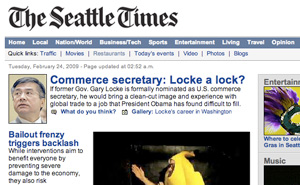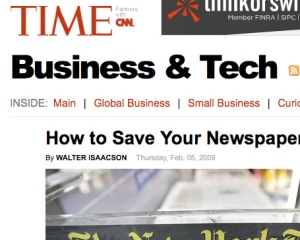In a couple of weeks, the Seattle Post-Intelligencer is due to stop publishing its print edition. In the spirit of prodding journalists to move on with life, and concentrate on re-energizing journalism in our communities, here’s some  unsolicited advice for the Seattle Times. This could be an opportunity for the news organization to take its freedom and run with it…into survival and eventual success. Instead of spending its last dime doing business as usual, it could start a major overhaul that would create a different and modern Web-based nichified news organization with a solid local foundation.
unsolicited advice for the Seattle Times. This could be an opportunity for the news organization to take its freedom and run with it…into survival and eventual success. Instead of spending its last dime doing business as usual, it could start a major overhaul that would create a different and modern Web-based nichified news organization with a solid local foundation.
A House that Jurnos and the Community Build
First, create geographic-based community sites: Put a pod of jurnos in each of the neighborhoods of Seattle that have a population of about 50,000 people, give or take a few thou. Each pod includes at least two reporters, an ad salesperson, and a community manager. (Take the U.S. News & World Report approach.)
Second, topic-based sites: Choose the beats you still own. Education? Transportation? Environment? Health? Rename them something catchier (for transportation, how does CantGetThereFromHere.com sound? Hey…I’ve been to Seattle.) And create another pod of jurnos for each of those sites. Reporters, ad salesperson, community manager.

Here's a rough graphic representation of the mini-metro network. Sumopaint's terrific online software, but it can't improve bad art skills. I'll ask my friend and graphics expert Val to fix it up, after folks send in some ideas on how to improve it.
Do a serious competitive analysis of these topic-based beats. Do you still own sports? Or have MaxPreps, the professional leagues, and CBS Sportline swooped in, as they have in almost every other metropolitan area? Has ESPN put Seattle on its list of local sites they’re developing? What about entertainment? Many national organizations glommed onto the local movie scene long ago, including Fandango, Rotten Tomatoes, IMDB.com. But maybe there’s enough local entertainment to keep a site alive. If a strong competitive topic-based site exists that has incorporated social networking, that serves its community members by giving them myriad ways to interact and provide useful information to each other…and many do, and that provides useful information, not just stories, move on to another topic.
Tango into the Webworld Format
Take the Web approach to create a social/news/information network. It’s so much more than a Web site. This must be a place the community thinks it owns. Remember the words “my newspaper”? Now you hear “my Facebook page”. You want people to think that way about this network. You want them to use it so much that they can’t figure out how they lived without it. (Talk to iPhone fanatics for inspiration. See how people use Craftster or Marketwatch and the Marketwatch Community.)
Map the communities. Find all relevant people and organizations that move and shake in a geographic-based community, or who push or put the brakes on issues in topic-based communities. Find out how the community works, how it communicates, what they need, what they want fixed. All that information gets organized into a Web shell of useful and user-friendly databases, resources, links, maps, etc. You don’t have to complete it before launch. Leave some for the community to add to and finish up.
Then, set up the site. Make the community the visual and functional engine. That means the site is a social network first. Big and prominent on the site is an easy sign-up. Free of charge. People have their own blogs, they form groups, they have discussions, they plan events, they buy and sell, give away and pick up, volunteer and ask for help. Anyone can look at anything on the site for free. People have to provide a real email address and their name if they want to participate. Their membership photos are on the home page. So are their blogs, links to their groups and their discussions.
The daily job of jurnos is to blog their beats. They post in a Webcentric way — some combination of text, still photos, videos, slide shows, graphics, polls, quizzes — a half-dozen or more times a day. They engage in a conversation with the community, which feeds them information (text, still photos, videos, slide shows, graphics). They ask this question about everything they put on the site: Is it immediate or contextual? Does it pick up or offer a chronological thread? Is it solution-oriented? How can I make this more participatory? Is this something that other communities would be interested in?
Sometimes jurnos do “traditional” iconic storytelling: a multi-part profile or analysis or summary.
The role of the jurno still fulfills important traditions passed down to us from the U.S. Constitution. We are fact-checkers, watchdogs, myth-busters, investigative reporters. Some people worry that if newspapers as we know them disappear, investigative reporting is doomed. In this network structure, I think investigative reporting thrives. In this structure, jurnos are much more involved in their communities, so problems are likely to be noticed sooner and followed more regularly. This approach has a better shot at preventing abuse. The other advantage is that jurnos can ask the community for input as they work on issues of individual or spot corruption or abuse, as TalkingPointsMemo did with the U.S. attorneys scandal.
What’s more important, though, is that with this structure, jurnos have a better shot at addressing issues of a corrupt, broken or ineffectual system that harms the community, such as a juvenile justice system that increases recidivism, or child welfare services that don’t protect children. They follow an issue until the community reaches its goal or resolves the issue. No more parachuting in and out of communities and stories.
This network does one more thing: it enables jurnos to share trusted information with each other. If it’s a smart network, then it can alert jurnos to similar issues cropping up in several communities, and help them work together on reporting an issue, as well as coordinate developments with jurnos in topic-based communities. This approach is already developing in a nascent form with Publish2.
Figure out how the content of this site can be accessible on people’s mobile phones. Start with the easy stuff first, useful information and tools that are branded and that drive people to participate more in the network.
This Can Make Money
The network is key to financing this operation. Geographic sites pick up the local advertisers who’ve been priced out of the paper for lo these many years. Examples of local ad-supported Web sites exist. One’s right there in West Seattle — WestSeattleBlog.com. (Key advice for the Seattle Times: Don’t try to compete with the WestSeattleBlog; learn from them; partner up with them; make them an offer they can’t refuse.) Topic-based sites pick up niche advertisers who’ve been priced out of the paper, as well as niche advertisers or general advertisers who want to reach several communities, or particular interest-based communities. Look at networks such as NameMedia, NetShelter, and Federated Media. Is it possible to develop a regional version of those national networks?
The organization doesn’t have to be all ad-based. It could throw a little Spot.Us into the mix, if the community gathers ’round an issue and wants to support an investigation. And for neighborhoods that don’t have enough business base to support a news network, perhaps some foundation money could get one started, and the jurnos could help foster the economic health of the community so that, eventually, enough business would exist to support the network.
The Paper
With a distributed news/information/social network, the Seattle Times won’t need a big central office anymore. Sell it. Rent it out. But keep the printing presses. Yes, it would still put out a paper. It won’t appear every day. And it won’t look ANYTHING like it does now. Model the content on the new Web approach: graphic, community-driven, pushing people to engage with the network, i.e., each other.
Maybe it comes out Thursday, Friday and Sunday, to coincide with the days that advertisers want to reach people in the community with a print product. Maybe Thursday’s food day, and the content focuses on everything food, from restaurant reviews, recipes, to issues such as local food safety or how the community’s doing on its goal of becoming a neighborhood of localvores. Maybe Friday’s local entertainment and weekend outdoor activities. The movies may have been sucked up by Fandango, but there’s probably much more local activity that could support a paper. Sunday’s inserts continue to be as interesting as what jurnos provide (jurnos recognize that the community values information and news in advertising as much as traditional news and they embrace it), and frame a mix of fun and summaries and analysis of community issues.
It’s a Bottom-Up World
A small group of editors — if it’s financially warranted — can aggregate information/stories from all the sites. In this scenario, 90 percent of the organization’s effort is put into a couple of dozen inch-wide, mile-deep sites, and small group puts together a Newser for Seattle.
If the Seattle Times starts now, it could keep its good name, its dedication to good journalism, and its good entrepreneurial jurnos — the kind of people who can nurture this nichified network through its growing pains. Maybe the organization won’t employ as many people as it does now, but in business-as-usual, the layoffs would continue anyway as the organization shrinks. A shift from mass-media to Web-based nichified media would encourage those who want to write only, who want to stay in a world of we-talk you-listen, who won’t embrace beat-blogging, who don’t see the value in social networking, to go somewhere else.
It would be a tough year or two of experimentation, learning to let the community help reconfigure what the news organization does for the community, learning to be flexible and agile, which means making as many mistakes in the shortest time possible, shouting out, “This is fascinating!” with each one. It’s uncomfortable, messy, uncertain, and scary. And that’s the way it’s supposed to feel if you’re making this very difficult and inspiring transition.
A friend once said about skydiving — if you ain’t scared, you ain’t having fun. In the case of transitioning to a Web-based medium, if you ain’t scared, you ain’t moving forward.
And if the Seattle Times ain’t moving forward, other folks will.
Here’s John Cook’s take on the Seattle situation. And his 10 steps for saving the Seattle P-I. He’s co-founder and executive editor for TechFlash, an online tech biz publication that’s partnered with the weekly Business Journal, which (obviously) also has a Web site.
Filed under: Advertising, Community manager, Jurno | Tagged: mini-metros, newser, nichification, publish2, seattle p-i, seattle times, smart network, spot.us, west, WestSeattleblog | 10 Comments »


 Brill
Brill 
 along and ruins our business as well by pulling the same trick: convincing the millions of interested readers who get their news every day free on newspapers sites that it’s time to pay up.
along and ruins our business as well by pulling the same trick: convincing the millions of interested readers who get their news every day free on newspapers sites that it’s time to pay up.![Reblog this post [with Zemanta]](https://i0.wp.com/img.zemanta.com/reblog_e.png)
 wholeheartedly.] He pointed out three myths:
wholeheartedly.] He pointed out three myths:
